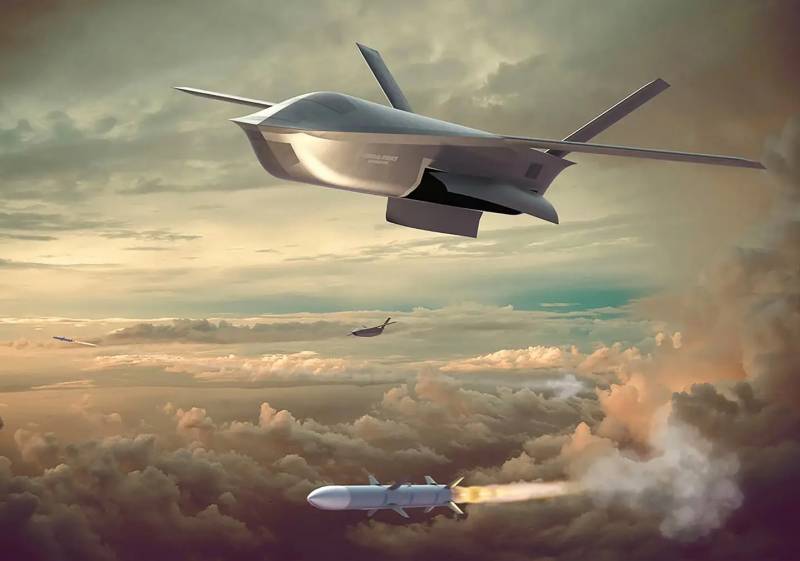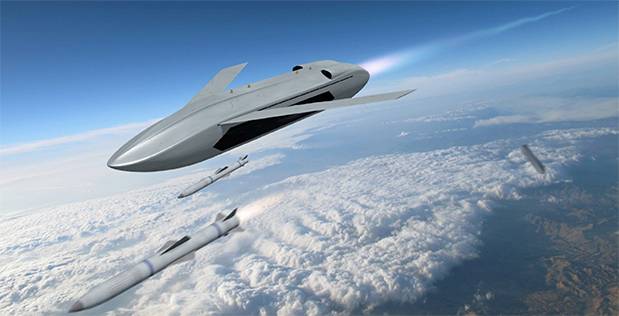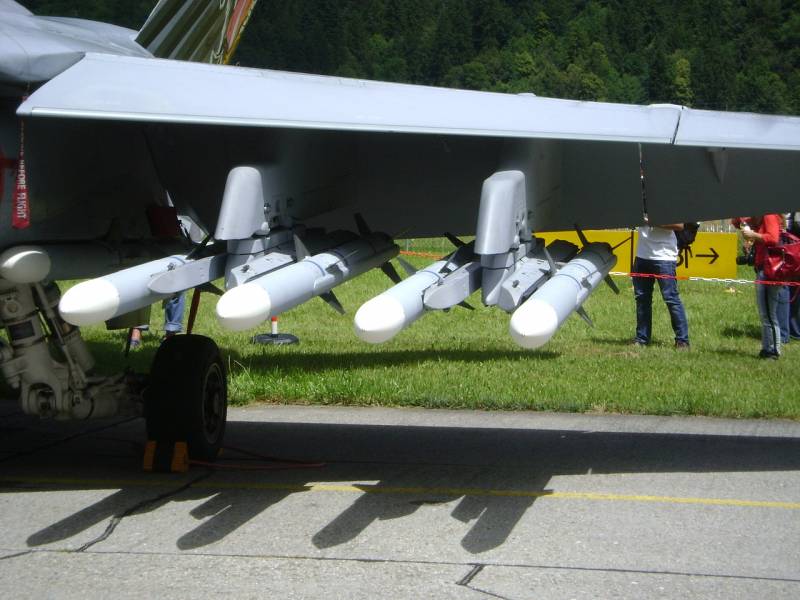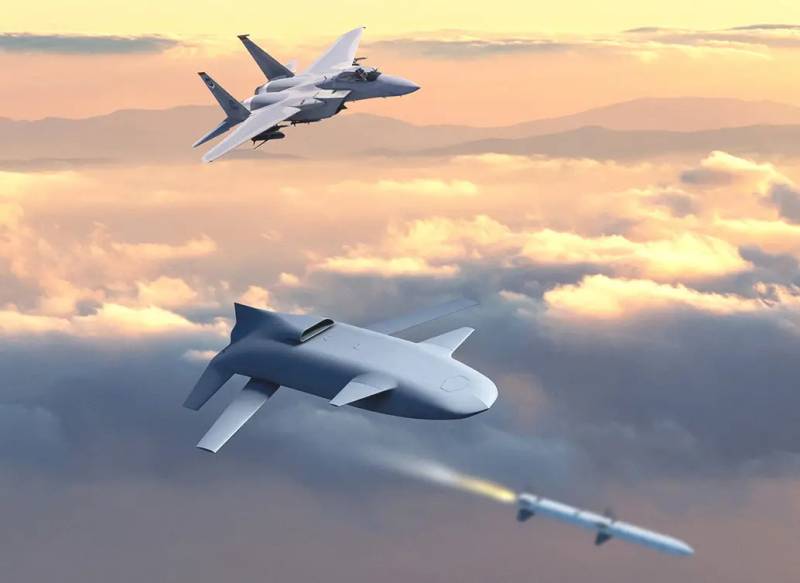DARPA LongShot program enters new phase

Early LongShot UAV concept from GA-ASI, 2021
The US Defense Advanced Research Projects Agency DARPA continues to implement the LongShot program. The goal of the work is to create an unmanned aerial vehicle with the function of carrying and using air-to-air missiles. Over the past few years, the program has been at the stage of competitive design development, and now the Agency has selected a contractor who will continue the work.
Stages of the project
The launch of the LongShot research program first became known in February 2020. Then the drafting of the military budget for the next fiscal year began, and in connection with this, some of the Pentagon’s needs were revealed, incl. in the context of advanced developments. The first phase of work, scheduled for FY2021, required $22 million.
A year later, in February 2021, DARPA officially launched the Longshot program and identified its participants. Contracts for the creation of preliminary designs were awarded to General Atomics Aeronautical Systems, Inc. (GA-ASI), Lockheed Martin and Northrop Grumman. The cost of the work was not disclosed at that time. Apparently, the previously requested 22 million was divided between the contestants.
The goal of the LongShot program is to create an aircraft-type UAV suitable for suspension on existing and future tactical platforms. aviation. Such a drone must carry guided air-to-air missiles of existing types and have a set of equipment for their use. The Longshot must launch from a carrier aircraft and deliver missiles to a remote launch site, increasing the overall combat radius of the aircraft complex.
Already in 2021, LongShot participating companies showed the first concepts of promising technology, and subsequently published new materials more than once. At the same time, projects were developed and revised. Thus, GA-ASI presented two options for the appearance of the UAV. Concepts 2021 and 2023 differ noticeably from each other.
The winner of the contest
To date, DARPA has received documentation from the competitors, compared the submitted projects and selected the most successful one. On September 7, GA-ASI officially announced that it had received a contract to continue developing its version of Longshot. The cost of the work has not yet been disclosed.
The management of the winning company notes that in recent years a lot of research has been carried out, during which a number of options for a promising UAV have been studied and tested. The best result was submitted to the competition and won it. Now it is planned to complete the design and move on to a new stage.
Apparently, the LongShot UAV project from GA-ASI is highly developed or even completely ready. Judging by the latest reports, the development company is already building experimental equipment and preparing to test it. The first flight tests are scheduled for December this year. It will probably start with a carrier aircraft, with drops, solo flights and rocket launches in the more distant future.
As work continues, costs for the LongShot program increase. So, in FY 2021 its budget was $22 million, and in 2022-23. 36 million were allocated for the work. For the new fiscal year 2024, starting October 1, spending is planned in the amount of just over $44 million. This will be enough to complete the assembly of the prototype(s) and start testing.
New look
After the start of work within the LongShot program, GA-ASI revealed its views on the appearance of a promising UAV. In total, three concepts were published with different features and significant differences. The last of them was attached to a recent press release about winning the competitive part of the program. This is probably the last version of the project that the customer is interested in, and it is this that will receive further development.
The picture from GA-ASI shows an unusual type of unmanned aerial vehicle with a “longitudinal triplane” design. It has a wide and flat fuselage with “unobtrusive” lines and a protruding upper air intake. The nose section has a trapezoidal front horizontal tail. In the center, shifted towards the tail, there is a forward-swept wing with high aspect ratio consoles. Perhaps the consoles are folding. The tail includes a small fin ridge on top and an L-shaped stabilizer.
Obviously, LongShot will be equipped with a turbojet engine with the required combination of dimensions and thrust. What flight characteristics it will provide is unknown. Perhaps the UAV will be trans- or supersonic. The combat radius is tens or hundreds of kilometers.

General UAV concept from DARPA
In the picture, LongShot launches an AIM-120 AMRAAM air-to-air missile. It flies out from under the bottom of the drone, but the method of transportation and launch cannot be determined. The ammunition load of such an aircraft also remains unknown. Judging by its size, the UAV can only carry a few missiles.
Independent flight and combat mission performance must be ensured by an autopilot. How exactly and on what components it will be built is unknown. The required functions and capabilities were also not specified.
The latest modification of the F-15 fighter is shown as the carrier of the UAV with missiles. There remains one more drone under its wing, ready for use. Judging by the dimensions of all elements of the complex, such a carrier can use no more than two or three LongShot products - one under each plane and, possibly, one under the fuselage. At the same time, the aircraft retains the ability to carry a certain number of missiles for independent use.
The performance characteristics of the LongShot UAV from GA-ASI are not disclosed. So far, the development company has limited itself to only the appearance of the product and “demonstration” of its main capabilities. Probably, in the future, the customer and the project implementer will publish the calculated characteristics and data from the tests, which will allow us to draw the first conclusions.
promising concept
GA-ASI received a Pentagon contract to complete the development, assembly and testing of the prototype LongShot UAV. The first flights on the carrier may take place as early as this year, but full-fledged tests with testing of all capabilities and functions will take considerable time and will only be completed in the indefinite future. However, it is already clear what the new drone could be, and why DARPA and the Air Force are interested in creating it and bringing it into operation.
The main idea of the project is quite simple: after being dropped from a carrier aircraft, the Longshot product must fly to a given point and use suspended aircraft weapons. This approach to using weapons has several advantages. First of all, this is an increase in the combat radius of the entire complex, because The radius of the UAV is added to the range of the aircraft and missile. Depending on the characteristics of the latter, the total radius can increase by hundreds of kilometers.

AIM-120 missiles under the wing of an F/A-18 fighter. Photo by Wikimedia Commons
The use of the LongShot UAV should reduce the risks for the carrier aircraft. To attack the intended target, he will not have to approach it within missile launch range - this will be done by a drone. It can be hit by the enemy, but the damage or loss of the aircraft will be more sensitive.
Perhaps, within the framework of the LongShot program, the issue of group use of unmanned aerial vehicles is being explored. In this case, several UAVs could jointly search for air targets, distribute them and launch missiles. Such a unit, depending on its size, can be launched and controlled by one fighter.
So far we are talking only about the possibility of using air-to-air missiles. However, in the course of further development, UAVs may receive weapon for hitting the ground. In this case, the unmanned system will retain all the main advantages and will be able to show high efficiency.
Additional link
Thus, the Pentagon, DARPA and their contractors continue to search for new ways and methods to improve the capabilities of combat aviation. As part of the ongoing LongShot program, they have looked at the possibility of introducing an additional "link" between the aircraft and the rocket. This idea has already undergone preliminary development, and in the foreseeable future it is going to be tested in practice.
It should be noted that the Longshot project is currently being created under the leadership of DARPA. This means that we are only talking about a technology demonstrator and testing new solutions. The creation of a full-fledged combat-ready UAV based on the program’s developments remains a matter of the distant future. How soon the development of such a drone will begin, and what it will be like, will become clear only after the completion of the main part of the testing of the current LongShot.

Information